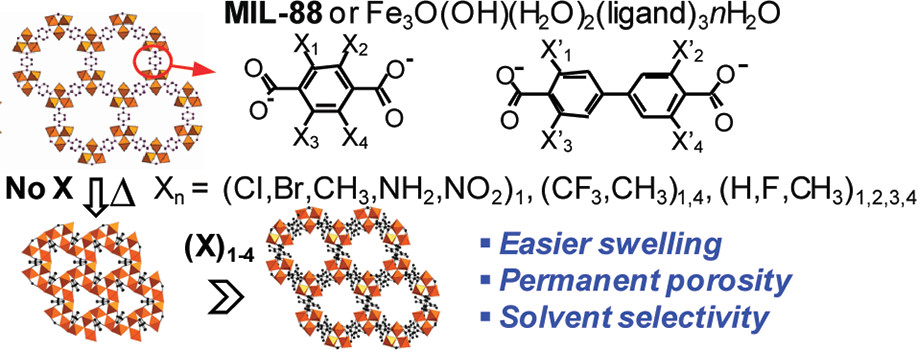Home >
News > How Linker's Modification Controls Swelling Properties of Highly Flexible Iron(III) Dicarboxylates MIL-88
How Linker's Modification Controls Swelling Properties of Highly Flexible Iron(III) Dicarboxylates MIL-88
Summary:
The authors from multiple organizations including Institut Lavoisier (UMR CNRS 8180), Université de Versailles, Institut C. Gerhardt Montpellier (UMR CNRS 5253), etc. developed a series of organically modified iron(III) dicarboxylates MIL-88B and MIL-88D flexible solids with tunable swelling properties, achieving results in understanding the relationship between linker modification and swelling properties in the field of metal-organic frameworks (MOFs).

Background:
1. Metal-organic frameworks (MOFs) are a class of porous solids with various applications, but most are rigid. A few flexible MOFs have unique framework flexibility, but studies on the effect of functionalizing organic linkers on flexible MOFs are scarce, and the modulation of the breathing phenomenon of the MIL-88 family using functionalized linkers is unexplored.
2. The authors synthesized a large series of functionalized MIL-88 solids and analyzed their swelling properties using a joint experimental/modeling approach, revealing the influence of linker modification on swelling.
Research Content:
1. Synthesis:
The authors synthesized MIL-88B solids with modified terephthalic acids and MIL-88D compounds using hydro or solvothermal conditions.
2. Characterizations:
1) BET results showed that some modified MIL-88B forms (e.g., 4CH₃) had significant surface areas (up to 1216 m²·g⁻¹), while others had low or no accessible porosity. Pore size distributions varied with functional groups.
2) X-ray diffraction (XRD) tests confirmed the structures belong to the MIL-88 type, with unit cell volumes varying in dried and open forms.
3) Thermal analysis (TGA, X-ray powder thermodiffraction) and IR spectroscopy were used to study thermal stability and solvent desorption behavior.
3. Application:
The materials' swelling properties in different solvents were tested, showing varying pore opening behaviors depending on functional groups and solvents, with potential applications in separation, catalysis, drug delivery, etc.
4. Mechanism:
The swelling amplitude depends on steric hindrance and number of functional groups per aromatic ring. Steric effects from functional groups affect intraframework interactions (e.g., π-π interactions), changing pore contraction and swelling ability. Computational analysis showed framework energy differences between open and closed forms influence swelling, with host-guest interactions and solvent properties also playing roles.

Outlook:
This research clarifies how linker modification controls the swelling properties of MIL-88, providing insights for designing flexible MOFs with tailored properties, and paves the way for their applications in various fields.
How Linker’s Modification Controls Swelling Properties of Highly Flexible Iron(III) Dicarboxylates MIL-88
Authors: Patricia Horcajada, Fabrice Salles, Stefan Wuttke, Thomas Devic, Daniela Heurtaux, Guillaume Maurin, Alexandre Vimont, Marco Daturi, Olivier David, Emmanuel Magnier, Norbert Stock, Yaroslav Filinchuk, Dmitry Popov, Christian Riekel, Gerard Ferey, Christian Serre
DOI: 10.1021/ja206936e
Link: https://pubs.acs.org/doi/10.1021/ja206936e
The above review is for academic progress sharing. For any errors or copyright issues, please contact us for correction or removal.

